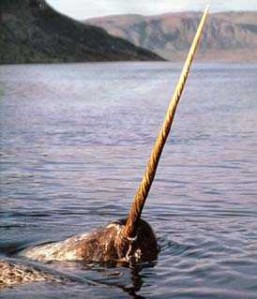The Last Unicorn in Medicine February 16, 2011
Author: Beach Combing | in : Medieval, Modern , trackbackOne of the most important things about mythical animals is that they are ‘rare’. Being rare means that anything to do with them is valuable and in previous ages that meant that their body parts were (a) good for showing off and (b) dragged into the world of medicine. Unicorns were particularly appreciated in medicinal texts: parts of the unicorn’s body being sold for vast sums to cure aristocratic hypochondriacs.
Indeed, already back in the twelfth century the crazy but always beguiling Hildegard of Bingen is coming up with recipes for blending unicorn’s liver with egg (what else?) as a preventive for leprosy. And in the following centuries there is interest in the virtues of the alicorn (the unicorn’s horn), probably via Arab sources, particularly its supposed ability to neutralise poisons.
The question that Beachcombing has set himself today is when does this interest die down and when do alicorns begin to be recognised for what they are: fossils, narwhales horns, whale bones etc etc?
Interestingly the latest source that Beachcombing has found dates to 1711 when instructions for cleaning teeth in one English book [Curiosa] are given as follows.
[Tooth cleaning] is done with rubbing them with powder of Aristolochia or Round Birthwort or with Sallow-tree, or powder of burnt hart’s horn, or mastick or unicorn’s horn or brick dust, which is esteemed the best.
So brick dust has it. Certainly brick dust would be a lot cheaper than alicorns that were of astronomical value in the 1600s: indeed, in the very early part of that century one royal horn was valued at 100,000 pounds. True by the 1700s prices had come down dramatically, but brick dust would still have been the cheaper option!
There are also a sprinkling of other roughly contemporary texts that have similar medical instructions involving alicorns. In a work of 1705 [Trifertes] we read that ‘cinnamon, unicorn’s horn and the liver of an eel’ help with the speedy deliver of childbirth, an eighteenth-century preoccupation given the mortality rates among mothers in labour.
A nice question is whether these authors though were not just using ‘unicorn’s horn’ as short hand. Certainly most authorities by the 1800s were under no illusion as to the non-existence of the unicorn and most knew what the alicorn really was.
‘The Unicorn’s Horn is sometimes eight Foot and more in Length, others of a smaller size, they are very sharp pointed, running Taper all along, and twisted, of the Colour of Ivory, and finer grain than any Ivory, and very white within; they are not of a Four-legged Creature, like to a Horse, but come from a Fish and therefore a Sea-Unicorn; they are brought from the Straight’s Davids, near the North Passage.’
Here there can be no question that the unicorn fish is the narwhale. Any later attempts to use the alicorn in medicine? Beachcombing would love to know. drbeachcombing AT yahoo DOT com



